Germany's
Jewish Knights of the Air
Introduction
During World War I warriors took to the skies for the first time in history. People of all nations were enthralled by the courage and daring of young men who were determined to fly despite primitive aircraft, insufficient training, physical hardships, and enemy fire. The fighter pilots were looked upon as "knights of the air" because they had a reputation for a certain amount of chivalry, especially compared to the soldiers on the ground. The essence of chivalry is recognizing the common humanity of our enemies, and treating them with as much dignity as wartime allows; chivalry puts boundaries and limits on cruelty and destruction during the waging of war. It is based upon Biblical principles, especially those expressed in Isaiah 1:17: "Make justice your aim; redress the wronged, hear the orphan's plea, defend the widow."
Many people have heard of famous World War I pilots such as America's Ace of Aces Eddie Rickenbacker or Canada's Billy Bishop, and even more have heard of "The Red Baron," Germany's Manfred von Richthofen. Most people are not aware that Germany also had over 130 Jewish airmen who served in the war as pilots, gunners and observers.
A few of those brave men are commemorated here.
IN MEMORIAM
This site is dedicated to the memory of the first Israeli astronaut,
Ilan Ramon

When
Colonel Ramon flew off in the Space Shuttle Columbia, he carried with
him a picture of the Earth in space drawn by a Jewish boy who had died
in a Nazi
concentration camp. Ramon took the dreams of his people to space with
him.
Ilan Ramon
stood on the shoulders of the Jewish aviation pioneers
commemorated here who, in spite of prejudice and adversity, persevered
with their dreams
of flying.
Acknowledgement
We have Felix A. Theilhaber, a Berlin physician, to thank for most of what we know about Germany's Jewish fighter pilots. Theilhaber served with distinction as a doctor in the German Army during World War I, and was dismayed to constantly hear in the media that Jews were not doing their part in the war effort. He was especially dismayed to hear that there were no Jewish fighter pilots because Jews were too cowardly to fly; he knew this was a lie and was determined to set the record straight. In 1916 he wrote a book called Die Juden und der Weltkrieg (The Jews and the World War). In 1918 he wrote Jüdische Flieger im Kriege (Jewish Flyers in the War) and revised it in 1924 as a volume called Jüdische Flieger im Weltkrieg (Jewish Flyers in the World War), in which he gave accounts of over one hundred Jewish soldiers who flew for Germany. The book was coldly received in Germany, and Theilhaber had a difficult time trying to advertise it or sell it.
In 1933 the Gestapo arrested Theilhaber for the research he was doing in the field of reproductive science. After his release he decided to immigrate to Palestine. In the midst of World War II he founded Kupat Cholim Maccabea Health Services. Today a wing of the Maccabea Health Services office building in Israel bears his name.
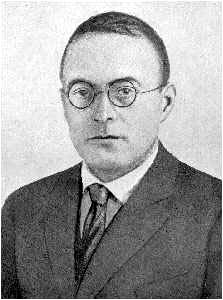
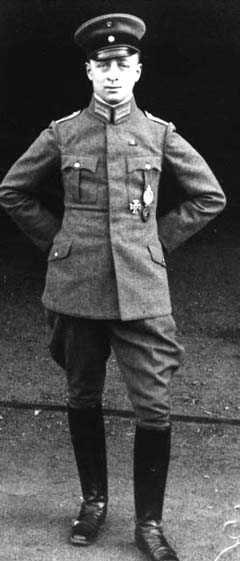
Willy Rosenstein was a World War I ace and a pre-war aviation pioneer. He was born in Stuttgart on January 28, 1892. Because he had a keen interest in engines and cars, he decided to become a motor engineer. In 1912 he earned his pilot's license (No. 170) at the famous flying school at Johannisthal. Soon afterwards he became a flight instructor, a test pilot, and a contestant in airplane competitions. His great flying talent made him nationally known. When war was declared in 1914, Rosenstein volunteered for duty as a pilot. At first he piloted two-seaters: while he flew the plane, another man would observe the enemy below. Later in the war the observers were armed with machine guns and participated in air combat. Pilots of one-seaters had both jobs of flying and shooting, and Rosenstein eventually became the pilot of a one-seater. From February to December 1917, Rosenstein was a member of Jasta 17, which was under the command of Lieutenant Hermann Goering. (Jasta was short for Jagdstaffel, or squadron. It was part of a Jagdgeschwader, or wing.) Rosenstein had his first confirmed aerial victory while in Jasta 17. In late 1917 an incident occurred in which Rosenstein became very upset after Lt. Goering made an anti-Semitic remark in front of several people; Rosenstein requested an apology but when Goering refused, Rosenstein asked for a transfer out of the unit.
In Rosenstein's official assessment, Goering wrote that Rosenstein was a fine pilot but that he was suffering from nervous exhaustion, and for a short while Rosenstein was assigned border duty. He eventually was transferred to Jasta 40, led by Lt. Carl Degelow, and Rosenstein flourished under his command. Rosenstein shot down several more enemy aircraft and was even made Deputy Staffelführer (squadron leader). Rosenstein always received excellent assessments from Degelow. Rosenstein received credit for shooting down seven enemy aircraft (shooting down five or more made you an "ace"), but he most probably deserved credit for two additional victories. His last two victories occurred near the end of the war and as a result, his claims were never officially processed. Among the decorations he received for his wartime service were the Iron Cross (First Class), the Order of the Zahringer Lion, and the Württemburg Service Medal in Gold.
Because World War I was so long ago and because of the Holocaust, photographs of Germany's Jewish fighter pilots are very rare. We are very fortunate that three photo albums belonging to Willy Rosenstein still exist. Rosenstein's photos and personal papers are part of the Robert B. Gill Collection, and Mr. Gill has generously allowed us to include here several photos from Rosenstein's photo albums:
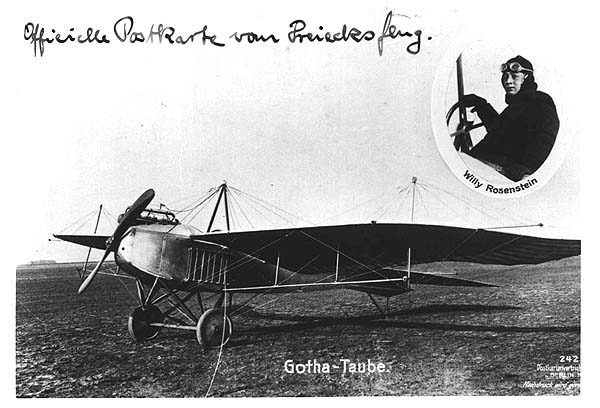
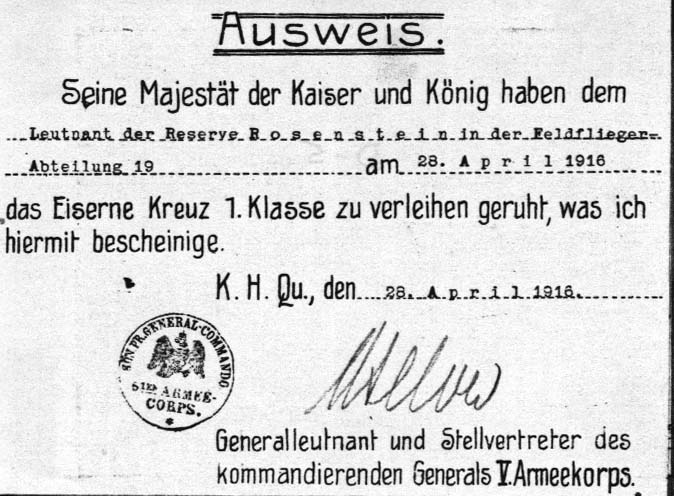
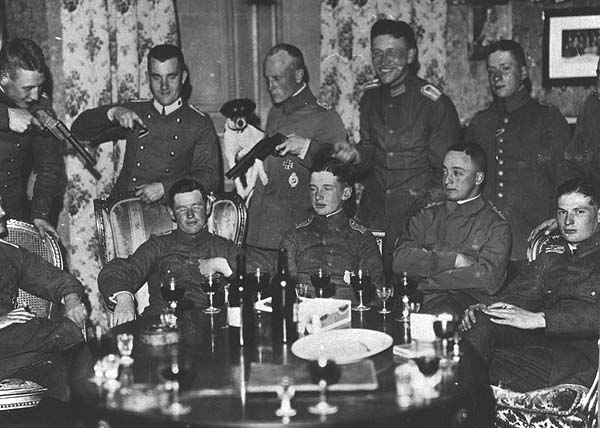

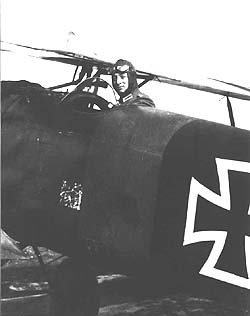
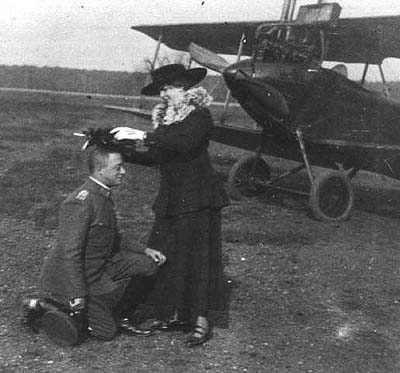
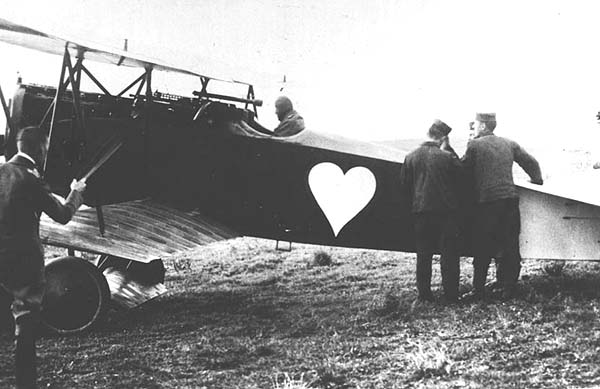
(For more on Willy Rosenstein, see the "After World War I" section on the next page.)